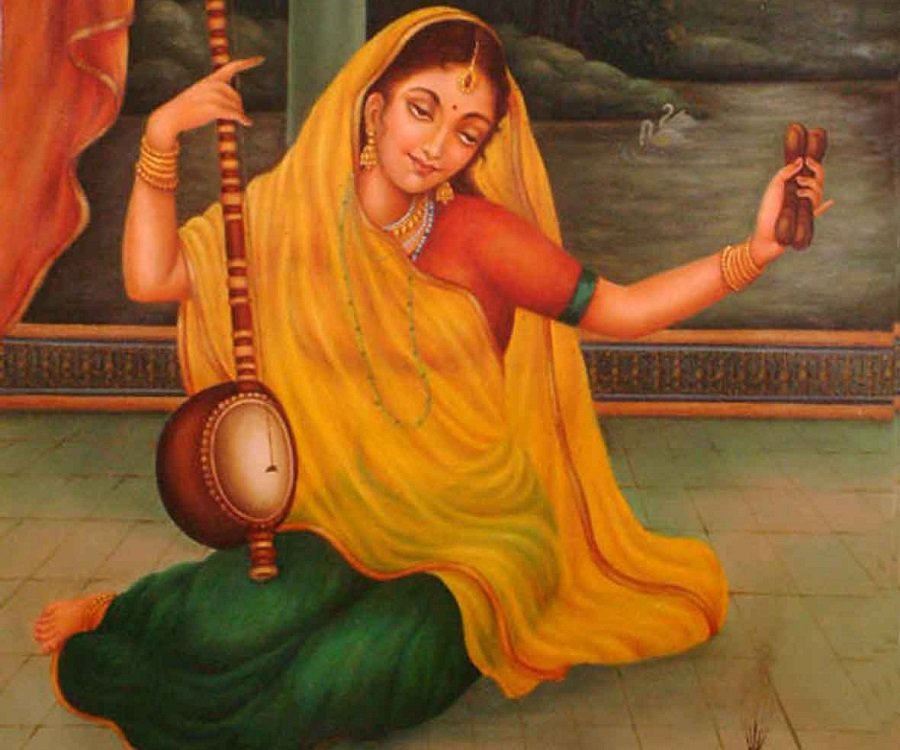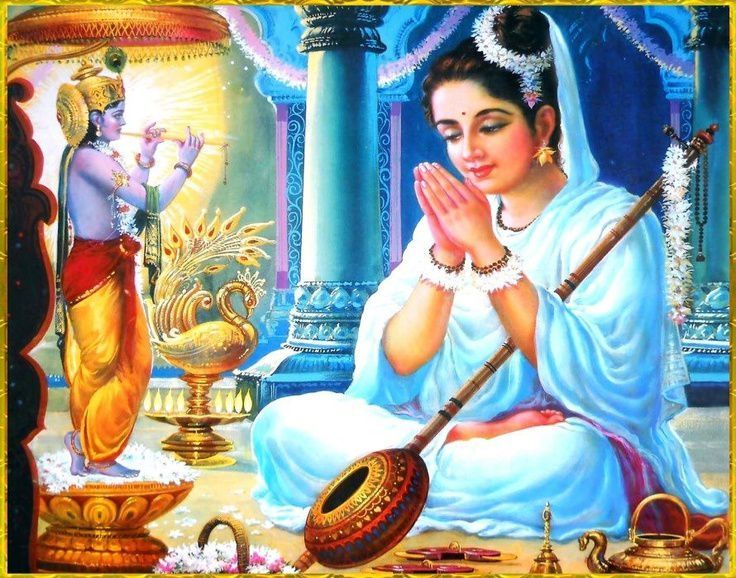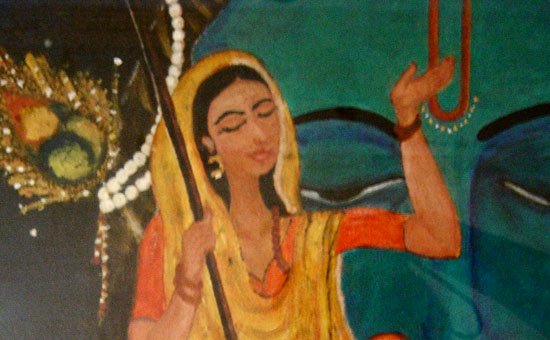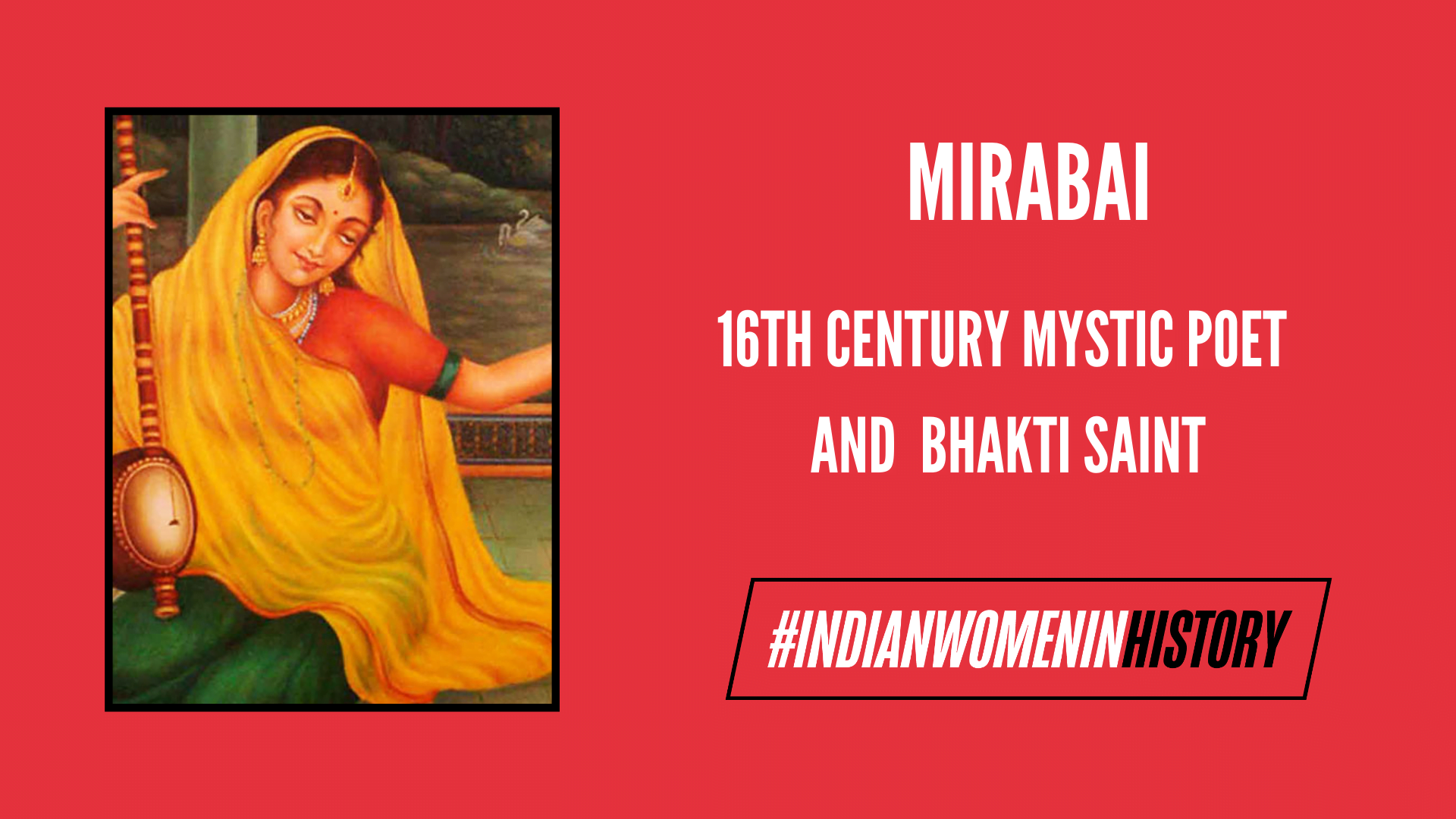Mirabai was a 16th century Rajasthani princess, a devotional songwriter, poet and a mystic who stood against the conventions of her times to voice her spiritual devotion for Krishna. As is the case with most ascetic figures, there are several versions of who Mira was and it is thus difficult to ascertain what parts of the legend are historically accurate and which are exaggeration and folklore.
Her influence in Bhakti poetry has been profound and innumerable devotional poems and songs (Padas & Bhajans) are attributed to Mirabai/Meerabai. She is popularly called and often regarded as the incarnation of Radha, the Hindu deity.

Mirabai’s biography
Her biography is also very fluid historically but it is generally believed that she was born in 149b A.D. in the village Kurkhi, near Merta in Rajasthan. Her father was Ratan Singh Rathore and her grandfather the famous Dudaji of Merta. The Rathores were devotees of Vishnu and Mira grew up amidst Vaishnava influence.
A famous anecdote often cited is that when Mira was just four years old, she witnessed a marriage procession. She saw the bridegroom and asked her mother, “Who is my bridegroom?” Mira’s mother in jest pointed towards the image of Lord Krishna and said, “Mira, Krishna, the most handsome, is your bridegroom“.
Mira, however, did not think of this as a mere joke and began to love the idol of Krishna as her consort and spent most of her time with the idol. When she was a teenager, as per custom, Mira’s marriage was arranged with Rana Kumbha/Bhoj Raj of Chittorgarh. Mira’s mother-in-law tried to impose on her to worship Durga as was the custom in their family, but she was completely devoted to Krishna.
Once Rana Kumbha’s sister Udabai told him that Mira was in love with someone else. She added that Mira went to meet him in the guise of serving Krishna at the temple. Enraged, Rana Kumbha broke open the door and rushed inside the temple one night, only to find Mira alone talking to the idol.

Image Credit: Hindu Mythology
Mirabai was persecuted in various ways by the Rana and his relatives, more so after he died in battle and she became a widow. Folklore has it that once a cobra was sent in a basket to her wrapped in a garland of flowers. But when she opened the basket there lay an idol of Krishna with the garland. She was sent a cup of poison as an offering. She offered it to Lord Krishna first as was her habit and then drank it; it didn’t harm her at all.
Popular folklore also has it that tortured continuously by her husband’s relatives, she wrote a letter to another great devotional poet of her times, Tulsidas, for advice. Tulsidas is said to have suggested that she must abandon those who do not understand her belief even though they might be her dearest relatives and that she must put her relationship with god above all other relationships.
It is also believed that hearing about her spreading fame as a special devotee, Akbar and Tansen visited Chittor in disguise to hear Mira’s devotional songs. Akbar was so moved that he gave a precious necklace as an offering. The secret visit didn’t remain a secret for long and when Rana came to know about it, Mira was told to drown herself in the river for revealing herself to a Mughal and thus bringing a huge disgrace to their family.
Mira soon left for Vrindavan, the destination for widows. The erstwhile princess and royal wife happily led the life of a hermit – writing poems, engaging in religious discourse and interacting with devotees. Her popularity as a singer and preacher is believed to have peaked during this period.
She spent her last days at Dwarka. In 1547, Mirabai was said to have died. According to folklore, she merged into the idol of Krishna and became one with him, as there is huge lack of information about her actual physical death. A Meera Memorial Trust known as Meera Smrithi Sansathan in the Chittorgarh district administration organises an Annual Meera Mahotsav or Sharad Purnima, celebrating the birth anniversary of this great woman saint.
Also Read: The Bhakti Movement and Roots of Indian Feminism
Subversion in poetry and life
Mirabai’s devotional poetry was only one of the most evident ways of her subversion. During the early 17th century, women were considered subordinate to men in spiritual worth and were meant to assist men in their worldly as well as religious pursuits.
Women were not even considered an individual in their own right and were bound to exist only to serve men. All the other prominent Bhakti movement poets were men. Mirabai defied not only the creative canon but showed open disregard to popular contemporary customs of Rajput clans. She refused to commit Sati on the death of her husband, insisting that her true spouse was forever Krishna. In one of her poems, she wrote:
Sati na hosyan girdhar gansyam mhara man moho ghanasami
(I will not commit Sati, my heart and soul belong to Ghanshyam)
She did not follow any of the other customs that Rajputs valued. She visited the temple and danced and sang in public, contrary to purdah/ghoonghat practised by other royal ladies. Overstepping the upper caste exclusiveness expected from a Rajput princess, she also freely mixed with other worshipers regardless of their gender or caste.
It is also believed that she accepted Saint Ravidas as her guru, who was part of the then ‘untouchable’ caste of leather workers. Some scholars believe that Mirabai herself wrote about two hundred songs and poems. But most of these were preserved through oral tradition, leading to the ambiguity about which were her original compositions and which were adaptations and additions by her followers.

Image Credit: eSamskriti
Mirabai was unique among the poet-saints of the Bhakti movement owing to her socio-economic background as well as her gender. Born a princess, she opted for the life of a mendicant and wanderer living a life of austerity and poverty to be spiritual.
Mirabai and canon
Mirabai belongs to a long, rich tradition of song-poems dedicated to Krishna, founded by the famous thirteenth-century poet Jayadeva. His epic Gita Govinda was the model for writing Bhakti poetry.
In the book Songs of the Saints of India, John Stratton Hawley says about Mirabai: “… she fired the imagination with her fearless defiance… the only one of her gender to have earned a place on the honour roll of north India Bhakti saints, she exerts a fascination that none of her male counterparts can match”.
In another song, she addresses the Rana:
Thara desa mein Rana saadh nahin chhe, log base sab kudo
(in your kingdom Rana, the people are all garbage)
Gehna gaanthi Rana hum sab tyaga, tyaga karro chuudo
(I have renounced all jewellery and finery, even my wedding bangles)
Kajal teeki hum sab tyagya, tyagya hai bandhan judo
(I have renounced all makeup and stopped tying my hair too)
This defiant image of a woman saint who openly walks the street with no shame or fear of authority is one of the most subversive images of royal women in those times. “Mirabai accomplished the impossible in her poetry; by making it an instrument of rebellion through a perfect blend of asceticism and aesthetics”, says Mridula Garg in a feature on Mirabai in The Hindu.
Her life has immense relevance today because her courageous story can find parallels in the lives of contemporary women who still have to fight opposition from families and society to live an independent and creative public life. Even today, we put a lot of pressure on single women to marry and devote their lives to domestic duties. Widows and divorcees are still not considered at par with “saubhagyavati” married women. Mirabai is the beacon for those who want to make their own choices and stick to them, whatever the social consequences.
Also Read: Why We Must Remember Poet And Saint Akka Mahadevi
Featured Image Credit: Famous People
About the author(s)
Pooja Priyamvada is a columnist, professional translator and an online content and Social Media consultant. She is also a writer/poet/editor/ and a bi-lingual blogger formerly also radio announcer and lecturer. She has an M.Phil. in English Literature from Panjab University and speaks vociferously about issues of gender, identity and marginalisation at a wide variety of platforms and mediums. A single parent and fibromyalgia survivor, she believes that she derives her strength from being a voracious reader and a tea connoisseur. Both her blogs have been awarded several times consecutively at the Orange Flower Awards and she has been associated with reputed national and international online addresses like The Mighty, Menstrupedia, Women’s Web, Feminism In India, ShethePeopleTV, Momspresso, Sheroes, Bonobology, Writersmelon and Sadaneera. Her translation titled A Night in the Hills, a collection of short stories by Manav Kaul has been published by Westland Books recently, besides she also translates for other forums like the Sahitya Akademi and The Raza Foundation. She is the author of an e-book Mental Health: A Primer. Her poetry and fiction have been published in several reputed online journals and print anthologies in India, UK and Canada and a few poems can be read with a hot cup of coffee on the walls of The Human Bean Cafe, Cobourg, Toronto. She has been featured amongst “10 Indian Women Bloggers you must follow” and “25 writers whose work readers enjoyed the most” at Women’s Web in 2018 and also in “Most empowering moments by Indian women” by SheThePeopleTV .




